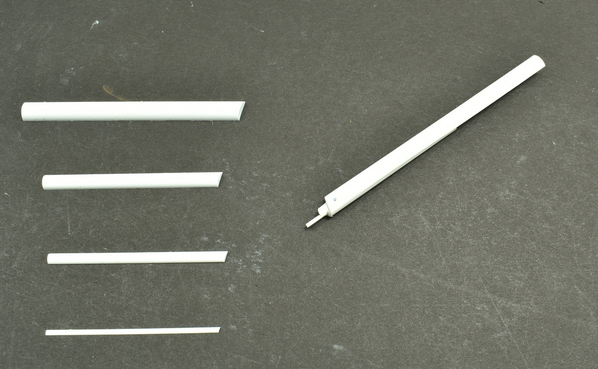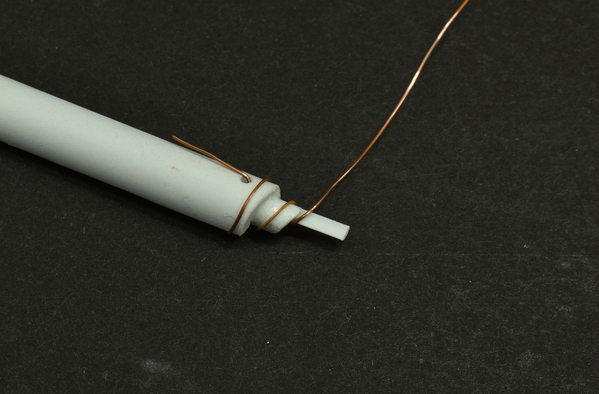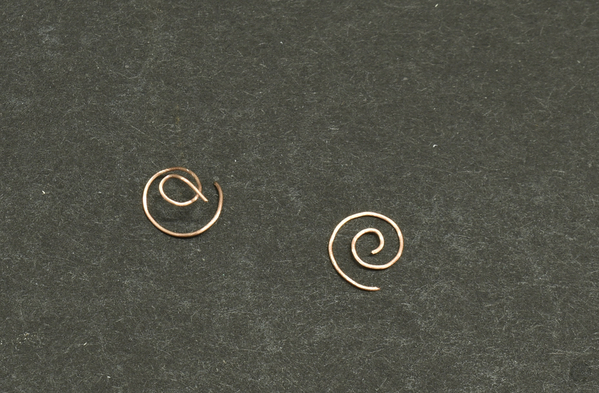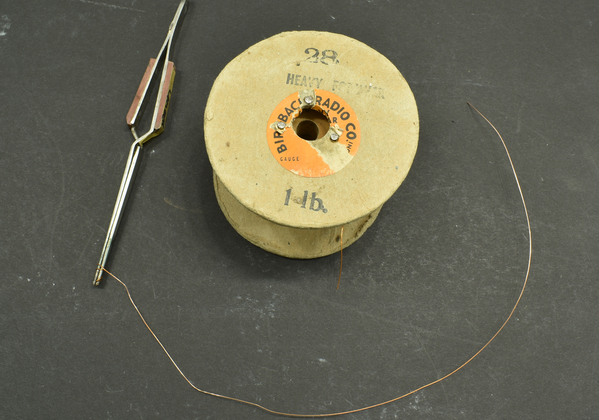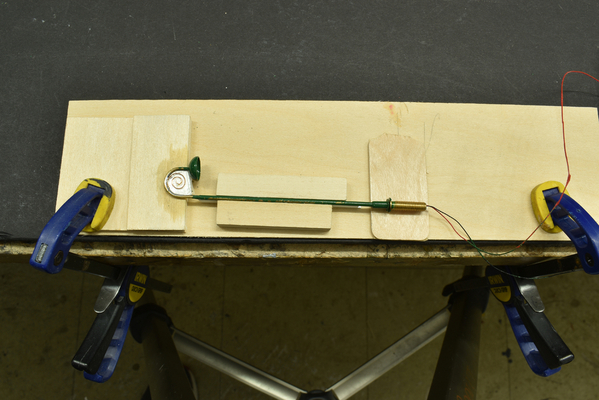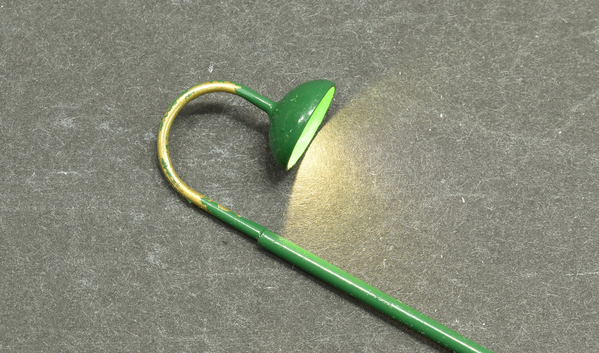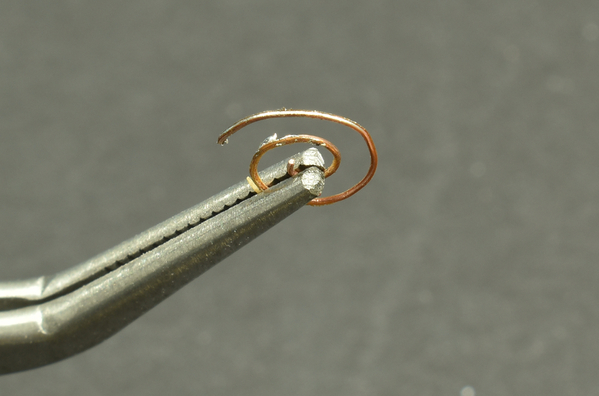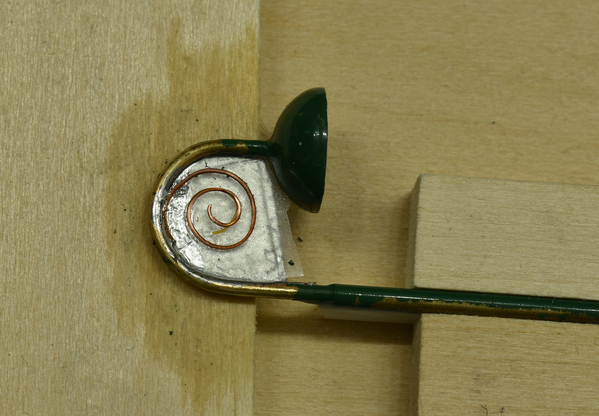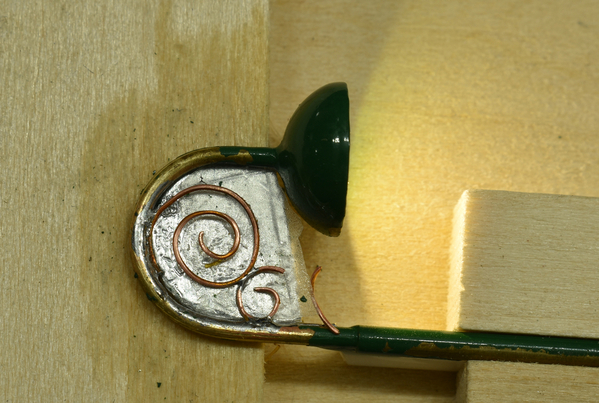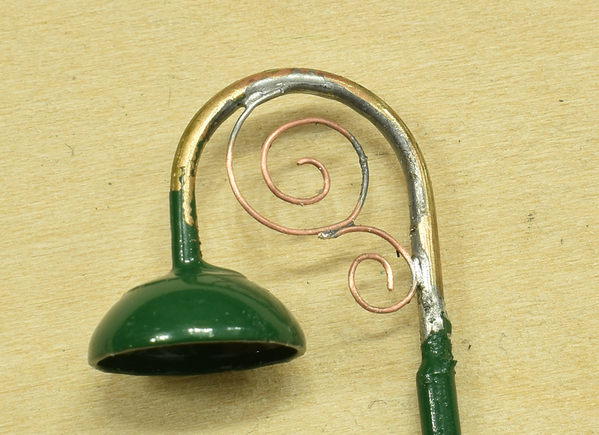The Pennsy had a very distinctive style lamp post for their station lights. They looked like a normal gooseneck lamp, except they had two decorative spirals added to the “neck.” You can easily find photos of the prototype on line. Here is my O scale rendition
And a close up of the top
I used Gooseneck lamp posts from “We Honest” on eBay. Their part number is 705sBG. (They are on Chinese New Year right now, and will begin offering these lamps again after Feb 20.) They are made brass, and have a surface mount LED under the lamp shade. They are very close to the overall dimensions of a Pennsy lamp post, right down to two component pole. So everything is correct, except they lack the decorative spirals.
A drawing of the lamp post can be found in PRR Standard Plan 58756-E. I have modified the drawing to give O scale dimensions, and colored the post and two spirals. The red is the main post, the green is the primary spiral, the blue is the secondary spiral
(Time out for a word about size: I have seen photos in which the overall diameter of the gooseneck appears to be bigger than the 18” shown above. It may be the camera perspective, or it may be Pennsy later changed the design. But in any event, I decided, to coin a phrase: to stick with the plan. Time in)
As you can see, the primary spiral really isn’t a spiral. It’s a series of four semi circles that decrease in radius after going through 180 degrees. The values of those four radii, in O Scale, are: .250, .188, .125 and .062.” Fortunately you can get styrene half rounds in these sizes from Evergreen. So I made a wrapping jig as shown below. The end of the half round is not cut square, but at an angle of about 30 degrees to allow the wire to make a smooth transition from one semi-circular arc to the next smaller one.
Here are the pieces I used, plus one view of the jig. The hole is to trap the wire as it is being wrapped.
Here is another view of the jig, with the wire wrapped on it
Here is the spiral after it is removed from the jig (left) and then flattened (right)
The secondary spiral is cut from the inner most winding of another primary spiral.
I used 28 gauge copper wire for the spiral. That’s a bit to thick for the prototype, but there is the small matter of being able to see it. You can also use 28 gauge brass wire, but its not as soft and a little bit difficult to work with--It wants to spring back after being wound, and it is harder to squish flat). The only 28 gauge wire I had was enameled, so I had to sand the insulation off. I cut off a length, held the end in a pair of clamp tweezers, and pulled it through a folded piece of 200 grit sandpaper
I built this jig to hold the lamp in place while I soldered the spirals in place
Not shown is the clamp that holds the lamp post in place.
That white you see under the lamp shade end is a piece of .020” thick styrene cut to match the inner circle of the gooseneck. This both fixes the gooseneck part of the lamp, and ensures the spiral is at the midplane of the gooseneck. The styrene is covered with aluminum foil so it does not melt under the soldering. A piece of removable double stick scotch tape is on top of the aluminum, and holds the spiral in place as it is being soldered. The tape needs to be replaced after each soldering step.
The first step is to remove all the paint in the gooseneck region. I used the edge a #11 blade, followed with acetone on a cotton swab:
After this, and every other procedure, I make sure the light still works:
If it does not, there is not a whole you can do about it. But at least you won’t waste anymore time on this particular lamp either. Next, tin the inner surface of the gooseneck. I use Superior No 30 Flux and Kester #245 “No Clean” Solder, 0.8 mm diameter:
Then tin the primary spiral at the point where it will meet the gooseneck at the top and the secondary spiral:
Now solder the main spiral in place. Apply flux with a cotton swab, apply a small bit of solder to the tip of your soldering tool, and touch it to the point where the spiral meets the gooseneck. Hold the spiral down with some suitable tool (I used an X-acto chisel blade.) When the sizzling stops, the solder has flowed.
I realize this soldering technique is a bit unorthodox and is counter to everything you learned in shop class. But it works very well because the liquid flux conducts heat very quickly throughout the intended joint, Be quick in this whole process, as you don’t want to melt the wires inside the brass tube. Test the lamp after soldering, Solder the secondary spiral to the primary spiral, using the same technique. Then solder the other end of the secondary spiral to the vertical segment of the gooseneck:
Ignore that stray piece of wire below the supporting spiral, it photo bombed my photo. Trim off all the excess wire and file away the solder where it is too heavy. And with that, you are done:
Before painting, make any needed corrections to the shape of the wire. Also remove excess solder with a small file. Clean the entire area with alcohol to remove any flux. I painted mine with Rustoleum Dark Gray Primer followed with a light mist of Rustoleum Satin Black.
In my opinion, these lamp posts really help to "Pennsy-ize" a scene:
To power the lights I use the JW&A - 20110 LED Lighting Regulator, designed by Forum regular gunrunnerjohn and available from Hennings Trains. I have four lamp posts on this platform connected to one regulator. (By the way, I have used these regulators for all sorts of lighting applications).
The other three lamp posts are at the other end of the platform:







